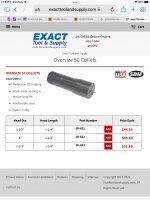jims
Hot Rolled
- Joined
- Sep 12, 2004
- Location
- Sonora , Calif
This will work for a lot of small parts. Where the length of part is critical and the stock od varies causing lengths to change. I bored a Hardinge emergency 5c collet to size needed , then drilled a cross hole thru side of collet. Drilled the hole with enough slop that when I slipped a 1/4 inch bolt thru hole and across face of fixed end of spindle the collet gripped stock but no pull back because bolt was free floating in hole . The bolt then became a stop when pushed against fixed against fixed end of machine. The bolt was free floating in hole but held in place by bolt head on one end and a nut on other end. So the collet grips the part and the bolt stops collet pull back.
Jimsehr
I also found a company that makes 5c emenercy extended length collets named Exact tool and supply that makes these collets to hold larger size parts.
Jimsehr
I also found a company that makes 5c emenercy extended length collets named Exact tool and supply that makes these collets to hold larger size parts.



